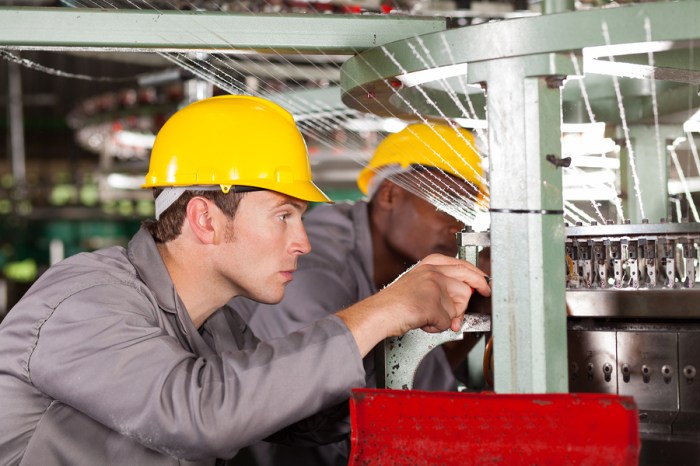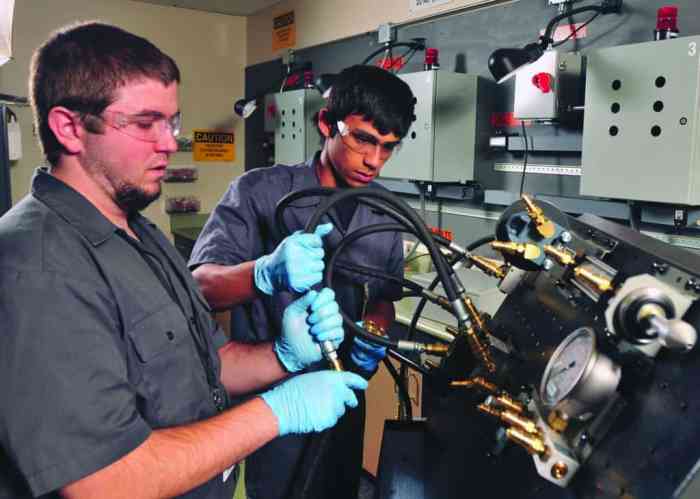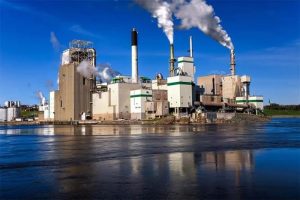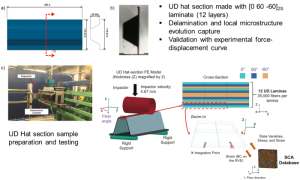
Buckle up as we dive into the realm of Industrial equipment maintenance trends, exploring the dynamic landscape of maintenance practices in various industries. Get ready to discover the exciting changes and innovations shaping the future of equipment maintenance!
Overview of Industrial Equipment Maintenance Trends
Industrial equipment maintenance is crucial for ensuring the smooth operation of machinery and preventing costly breakdowns. With the advancement of technology, the landscape of maintenance practices in industries is rapidly evolving. Let’s delve into the key factors driving these changes and explore some examples of modern technologies revolutionizing maintenance processes.
Key Factors Driving Changes in Industrial Equipment Maintenance Practices
- Rise of predictive maintenance: Utilizing IoT sensors and data analytics, predictive maintenance allows companies to anticipate equipment failures before they occur, reducing downtime and saving costs.
- Adoption of cloud-based maintenance management systems: Cloud-based solutions provide real-time access to maintenance data, enabling better decision-making and resource allocation.
- Focus on sustainability and energy efficiency: Companies are increasingly incorporating maintenance strategies that prioritize energy efficiency and sustainability to reduce environmental impact.
Modern Technologies Revolutionizing Maintenance Processes in Industries
- Augmented reality (AR) for remote assistance: AR technology allows maintenance technicians to receive real-time guidance from experts, improving efficiency and reducing downtime.
- Condition monitoring with sensors: Installing sensors on equipment enables continuous monitoring of performance, helping to detect issues early and optimize maintenance schedules.
- Robotics and automation: Automated maintenance processes using robotics can perform repetitive tasks with precision, freeing up human resources for more complex maintenance activities.
Predictive Maintenance in Industrial Settings
Predictive maintenance is a proactive approach to equipment maintenance that uses data analysis, machine learning, and sensor technologies to predict when a piece of equipment is likely to fail. By analyzing historical data, patterns, and trends, maintenance teams can identify potential issues before they cause costly breakdowns.
Technologies and Tools for Predictive Maintenance
- Predictive Analytics: Utilizing algorithms to analyze historical data and identify patterns that indicate potential equipment failure.
- Condition Monitoring Sensors: Installing sensors on equipment to monitor variables such as temperature, vibration, and oil levels in real-time.
- Machine Learning: Training algorithms to recognize patterns and anomalies in equipment performance data to predict maintenance needs.
- Internet of Things (IoT): Connecting equipment to a network to gather real-time data and enable remote monitoring and diagnostics.
Benefits of Predictive Maintenance
- Cost Savings: By predicting maintenance needs in advance, companies can avoid costly unplanned downtime and reduce maintenance costs.
- Increased Equipment Lifespan: Proactively addressing maintenance needs can extend the lifespan of equipment and improve overall reliability.
- Improved Safety: Predictive maintenance helps prevent equipment failures that could pose safety risks to workers.
- Enhanced Productivity: Minimizing downtime and optimizing maintenance schedules can improve overall productivity and efficiency in industrial operations.
IoT and Industry 4.0 Impact on Equipment Maintenance
IoT and Industry 4.0 technologies are revolutionizing industrial equipment maintenance by enabling smarter, more efficient processes. These advancements are reshaping the way maintenance tasks are carried out, moving from reactive to proactive strategies.
IoT in Equipment Maintenance
IoT allows industrial equipment to be connected and communicate data in real-time. Sensors embedded in machines collect information on performance, temperature, vibration, and other key metrics. This data is then analyzed to detect patterns, anomalies, and potential issues before they lead to costly breakdowns. Predictive maintenance based on IoT data helps organizations schedule repairs or replacements at the optimal time, reducing downtime and extending equipment lifespan.
Industry 4.0 Technologies in Predictive Maintenance
Industry 4.0 technologies like AI and machine learning play a crucial role in predictive maintenance. These tools can process vast amounts of data to identify trends, predict failures, and recommend maintenance actions. AI algorithms can learn from historical maintenance records and performance data to continuously improve maintenance strategies. By leveraging these advanced technologies, organizations can optimize maintenance schedules, reduce costs, and increase overall equipment reliability.
Examples of Connected Devices in Equipment Monitoring
Connected devices, such as smart sensors and wearables, offer real-time monitoring of equipment health and performance. For instance, a connected pump in a manufacturing plant can send alerts when operating parameters deviate from the norm, indicating a potential issue. Maintenance teams can access this data remotely and take preventive action to avoid unplanned downtime. Additionally, IoT-enabled platforms can provide insights into equipment usage patterns, helping organizations make informed decisions about maintenance intervals and resource allocation.
Sustainability and Green Practices in Industrial Equipment Maintenance
In recent years, there has been a significant shift towards sustainable and eco-friendly maintenance practices in industries. Companies are realizing the importance of incorporating green initiatives into their equipment maintenance strategies to reduce environmental impact and promote sustainability.
Adoption of Renewable Energy Sources
Many industrial facilities are now integrating renewable energy sources such as solar panels and wind turbines to power their equipment. This not only reduces carbon emissions but also lowers energy costs in the long run.
Implementation of Eco-Friendly Lubricants and Fluids
Another common practice is the use of eco-friendly lubricants and fluids in industrial equipment. These alternatives are biodegradable and non-toxic, minimizing harm to the environment during maintenance activities.
Investment in Energy-Efficient Equipment
Companies are investing in energy-efficient equipment that consumes less power and requires minimal maintenance. This not only reduces operational costs but also decreases the overall carbon footprint of the industry.
Embracing Circular Economy Principles
Industrial sectors are increasingly adopting circular economy principles by reusing and recycling materials to extend the lifespan of equipment. This approach not only reduces waste but also promotes a more sustainable maintenance culture.
Training and Skill Development for Maintenance Personnel

Training and skill development are crucial for maintenance personnel in industrial settings to ensure the efficient operation and longevity of equipment. By continuously upskilling their workforce, companies can adapt to evolving maintenance trends and technologies, ultimately improving overall productivity and reducing downtime.
Specialized Skills for Effective Industrial Equipment Maintenance
- Technical Expertise: Maintenance personnel must have a deep understanding of the industrial equipment they are responsible for, including mechanical, electrical, and hydraulic systems.
- Diagnostic Skills: Being able to troubleshoot and identify issues quickly and accurately is essential for minimizing downtime and preventing costly breakdowns.
- Preventive Maintenance Knowledge: Knowledge of preventive maintenance practices helps in proactively addressing potential problems before they escalate.
- Data Analysis: With the rise of predictive maintenance technologies, maintenance personnel need to be skilled in analyzing data to predict equipment failures and plan maintenance activities accordingly.
Continuous Learning and Upskilling in Maintenance
Continuous learning is key for maintenance personnel to stay updated on the latest technologies and best practices in the industry. Upskilling programs can include training on new equipment, software, and maintenance techniques to ensure that maintenance staff can effectively manage and maintain industrial equipment in a rapidly changing environment.
Emerging Technologies in Industrial Goods and Services
Robotics and Automation are revolutionizing the industrial sector, enhancing efficiency, accuracy, and safety in maintenance processes and services. These emerging technologies are reshaping the landscape of industrial goods and services, leading to a more streamlined and cost-effective approach.
Integration of Robotics and Automation
One of the key trends in industrial maintenance is the integration of robotics and automation to streamline operations and enhance productivity. Advanced robotic systems are being used for tasks such as predictive maintenance, asset tracking, and equipment monitoring in industrial settings. These technologies help reduce downtime, minimize errors, and improve overall operational efficiency.
AI in Industrial Maintenance Services
The use of Artificial Intelligence (AI) in industrial maintenance services is gaining momentum, with AI-powered systems analyzing data to predict equipment failures before they occur. By leveraging AI algorithms, maintenance teams can proactively address issues, optimize maintenance schedules, and extend the lifespan of industrial equipment. This predictive maintenance approach is transforming the way maintenance is conducted, shifting from reactive to proactive strategies.
Case Studies of Successful Implementation
- Company X implemented robotic systems for equipment inspection and maintenance, resulting in a 30% reduction in downtime and a 20% increase in operational efficiency.
- Company Y utilized AI algorithms to predict maintenance needs for their manufacturing equipment, leading to a 15% decrease in maintenance costs and a 25% improvement in equipment uptime.
- Company Z integrated automation technologies for inventory management, reducing inventory holding costs by 20% and improving inventory accuracy by 15%.
Concluding Remarks

In conclusion, Industrial equipment maintenance trends are evolving rapidly, driven by technological advancements and a focus on sustainability. Stay informed and adapt to these trends to ensure optimal performance and longevity of industrial equipment.
FAQ Insights
What are the key factors driving changes in industrial equipment maintenance practices?
The key factors include technological advancements, the shift towards predictive maintenance, and the focus on sustainability.
How does IoT impact equipment maintenance in industries?
IoT enables real-time monitoring, predictive maintenance, and optimization of maintenance schedules for industrial equipment.
Why is training and skill development crucial for maintenance personnel in industrial settings?
Training ensures that maintenance staff have the specialized skills needed to effectively maintain industrial equipment and adapt to evolving trends.





